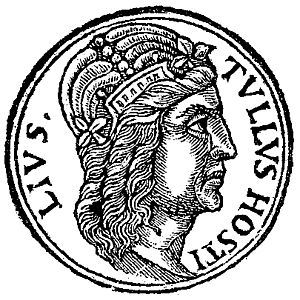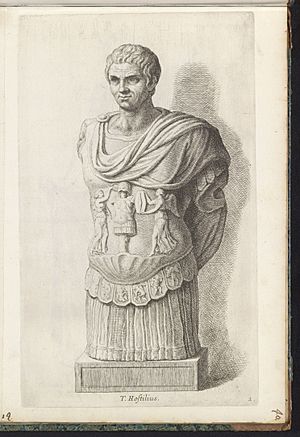Tullus Hostilius facts for kids
Quick facts for kids Tullus Hostilius |
|
|---|---|

Tullus Hostilius, 16th-century woodcut by Guillaume Rouillé
|
|
| King of Rome | |
| Reign | c. 672–640 BC |
| Predecessor | Numa Pompilius |
| Successor | Ancus Marcius |
Tullus Hostilius was the third legendary King of Rome, ruling from around 672 to 640 BC. He followed Numa Pompilius and was succeeded by Ancus Marcius. Unlike the peaceful Numa, Tullus was known as a very warlike king. The Roman historian Livy wrote that Tullus believed Numa's peaceful rule had made Rome weak. Some accounts even say he was more warlike than Rome's first king, Romulus.
Stories about Tullus Hostilius's death are different. One legend says he made Jupiter angry, and Jupiter killed him with a lightning bolt. Other historical sources suggest he died from a plague after ruling for 32 years.
Tullus Hostilius was the grandson of Hostus Hostilius. His grandfather fought alongside Romulus and died during the Sabine attack on Rome.
A key event during Tullus's time as king was the defeat of Alba Longa. After Rome won, Alba Longa became a state controlled by Rome. Tullus also created the college of the Fetiales. These were priests who made all treaties and agreements for Rome.
Contents
Major Events During Tullus's Reign
Two important events are often linked to Tullus Hostilius's rule. Historians believe these events happened early in Rome's history. However, they debate if Tullus Hostilius was directly involved.
The first event is the destruction of Alba Longa. Historical records show that the Alban Hills had a large settlement. This settlement later came under Roman control. It's not fully clear when or by whom Alba Longa was destroyed. It might have been conquered later than Livy suggests. Some think the Latins destroyed it, not the Romans.
The Battle for Alba Longa
The battle between Rome and Alba Longa was decided in a unique way. Each city had a set of triplets born around the same time. These triplets fought each other in a deadly combat. The last person standing would win the war for their city. This meant the armies didn't have to fight.
The story says these triplets were chosen as champions. According to Livy, most people believe the Roman triplets were called Horatii. The triplets from Alba Longa were called Curiatii. After a long fight, the last Roman brother won. This victory meant Rome and Tullus Hostilius won the war against Alba Longa.
The leader of Alba Longa, Mettius Fufetius, later betrayed Rome. This happened during a war with the Etruscans. Rome asked Alba Longa for military help, and Mettius agreed. But he secretly planned to abandon Rome during the battle. Mettius also betrayed the Etruscans by not joining the fight at all. Tullus still won the battle despite this betrayal. Mettius was captured by Tullus.
Tullus ordered Alba Longa to be destroyed. He forced the people of Alba Longa to move to Rome. There, they became Roman citizens. For his betrayal, Tullus had Mettius Fufetius tied between two chariots. The horses were then made to pull in opposite directions. This was a very harsh punishment. According to Jaclyn Neel, Romans used this method of execution only once.
Building the Curia Hostilia
Tullus's second major achievement was building the first Roman Senate House. This building was called the Curia Hostilia. After leaders from Alba Longa joined the Roman Senate, a bigger building was needed. The Curia Hostilia was built to hold the larger Senate.
Tradition says Tullus built and named the Curia Hostilia. Remains of the building in the Forum date back to around 600 BC. This date is later than Tullus's traditional reign. However, scholars question the very long reigns given to early Roman kings. A more recent idea suggests the Roman kings ruled for a shorter period, about 120 years. This shorter timeline would place the building of the Curia Hostilia within Tullus Hostilius's reign. It also helps explain how Tullus could have led Rome's successful wars against the Fidenae and Veii and the Sabines.
Tullus Hostilius in Myth
Like all early Roman kings, the stories about Tullus Hostilius are viewed carefully by modern historians. Some parts of his story might be similar to those of Romulus. Both are said to have grown up among shepherds. Both fought wars against Fidenae and Veii. They both also increased the number of citizens and organized the army.
Also, Tullus Hostilius's fierce and warlike personality seems to be a strong contrast to the peaceful Numa Pompilius. Some historians think early Roman writers might have given him aggressive traits just because his family name, Hostilius, sounds like "hostile" in Latin.
However, Tullus Hostilius was likely a real person. His first name, "Tullus," is quite rare in Roman culture. His family name is also old and unusual. This suggests he wasn't just made up later.
The Death of Tullus Hostilius
According to Livy, Tullus didn't pay much attention to religious duties during his rule. He thought they were not important for a king. But near the end of his reign, strange things happened in Rome. Stones fell from the sky on the Alban Mount. A loud voice was heard complaining that the Albans had forgotten their old gods. A sickness also spread in Rome.
King Tullus became ill and started to believe in superstitions. He read Numa Pompilius's writings and tried to perform sacrifices. However, Tullus did not do the ceremony to Jupiter Elicius correctly. As a result, Jupiter became angry. Both Tullus and his house were struck by lightning and turned to ashes.
There are two main stories about how Tullus Hostilius and his family died. The first is the one by Livy, where lightning struck his house, and everyone died. The second story says that Ancus Marcius and some followers went to Tullus Hostilius's home. They had swords hidden under their clothes. Once inside, they killed Tullus, his family, and their servants. They then destroyed the house to make sure there was no one left to take the throne.
Tullus Hostilius in Stories and Films
Events from the legends about Tullus Hostilius have been used in operas. The first opera about him, Tullo Ostilio, was performed in Rome in 1694. Later operas with the same title included music by Antonio Vivaldi. These operas often added love stories involving the characters' families.
Tullus Hostilius was played by Robert Keith in the 1961 film Duel of Champions. This movie focused on the story of the Horatii triplets.
Tullus is also briefly mentioned in the Aeneid, a famous Roman epic poem. He is described on Aeneas's shield, pulling away the body of the traitor Mettius.
He is a character in Philip José Farmer's novel To Your Scattered Bodies Go. This is the first book in the Riverworld series. In the story, after everyone is brought back to life, Tullus teams up with Hermann Göring to run a slave state.
See also
 In Spanish: Tulo Hostilio para niños
In Spanish: Tulo Hostilio para niños
- Hostilia gens


